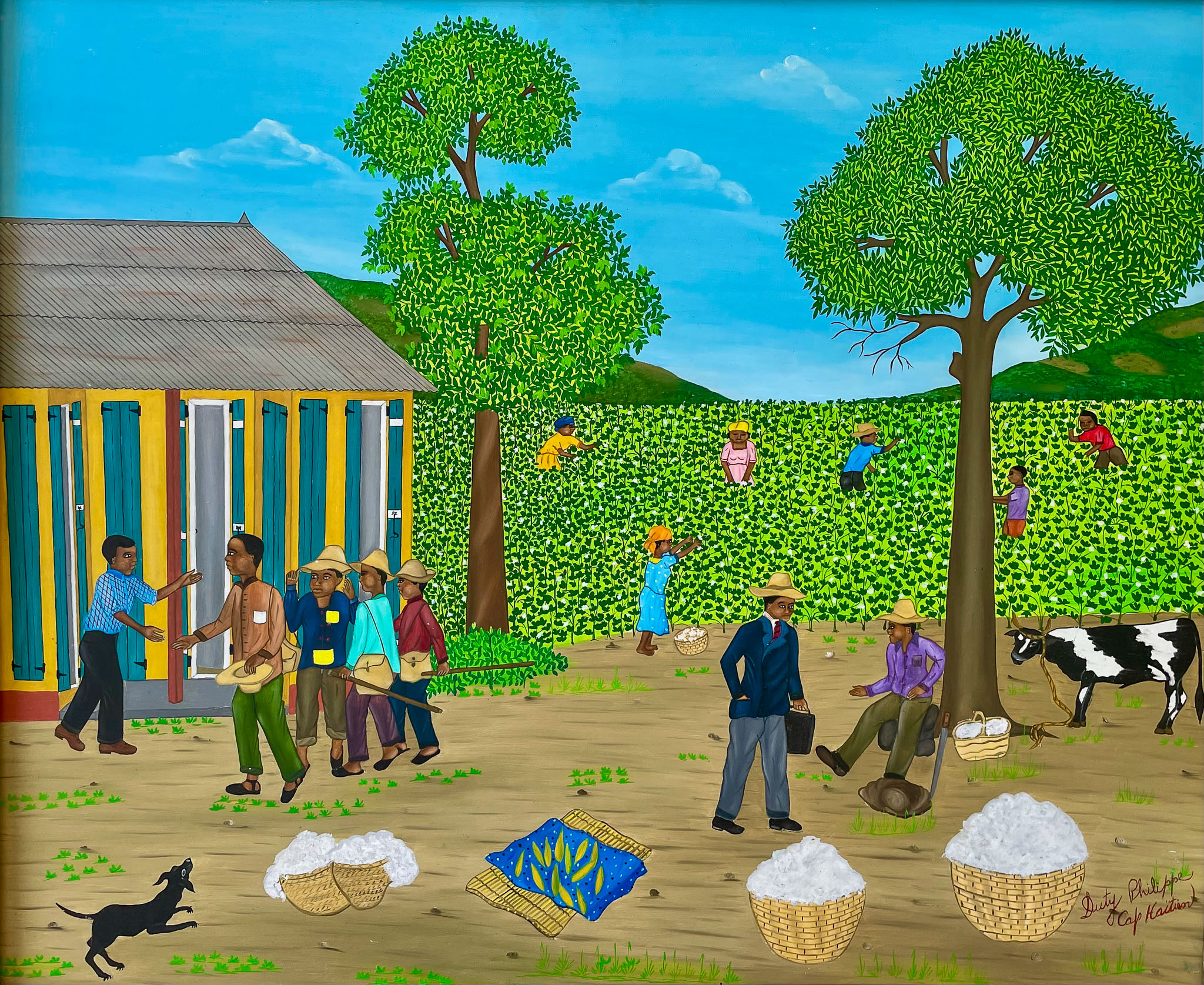Postcard From Haiti: July 2024 by Rick Forgham
This Postcard From Haiti is lovingly dedicated to the memory of Beverly Sullivan whose love for all things Haitian affected so many of us.It is perhaps a little-known fact that cotton was at one time Haiti’s fourth largest cash crop and the income earned was the economic back-bone of many rural communities. In this painting by Cap Haitian artist Duty Philippe one can see his representation of the agricultural, social, and commercial activity surrounding the traditional cultivation of cotton in Haiti in the 1970s.
Women and men are shown in the field harvesting the cotton. A group of area farmers are paying a visit to a village resident while a cotton broker carrying a briefcase holding money has arrived to negotiate the purchase of several baskets full of freshly harvested cotton.
The cow that is tethered to the root of the tree under which the farmer is sitting likely represents the economic prosperity that resulted from harvests of years past.
This scene would have been repeated countless times in villages all over the lowland areas of Haiti from the colonial period through the end of the 1980s. During better times, both politically and economically, Haiti’s cotton was converted domestically into denim fabric and by 1970 had been discovered by designers for its unique irregular texture and nubby feel. Fashion designer Lucienne Liautaud created a successful line of hand-made crochet apparel. In contrast, the American interior designer Lawrence Peabody incorporated hand-loomed and brilliantly colored vat-dyed Haitian cotton textiles into his internationally acclaimed home furnishings lines. I’ve named only a few of the designers and for a while in the 1970s and early 1980s, this unique fiber was incorporated into countless handcrafts produced by the talented artisans of Haiti, from placemats to lampshades, it seemed to be everywhere!
Success almost always invites imitation, and it did not take long for the industrial cotton mills of India and China to copy the look of “Haitian Cotton” as it became known in the design world. Once the look of Haitian Cotton became available in assured supplies at a predictable price it was not long before the furniture industry centered in North Carolina offered the look and feel to the public. However, the material was only “Haitian” in name for its origins and manufacture were from the opposite side of the globe. Sadly, due to turmoil in Haiti and the cyclical lack of global demand that depressed cotton prices, the farming of cotton in Haiti completely collapsed by the end of the 1980s.
Fast-forward to 2018 and the initiatives of the Small Holder Farmers Alliance. Headed by Hugh Locke, the small-scale farming of Haitian cotton began to once again take hold. Buoyed by a partnership with the American apparel manufacturer Timberland and the firm’s solid commitment to utilize Haitian-grown cotton for some of its products, the program had the funding to assure its initial success. Soon some fifty smallholder farms were able to produce almost 30,000 pounds of organically grown cotton that was ginned and baled for export to Timberland in the United States for conversion into fabric to be used in Timberland’s shoe line. In the spring of 2021, Timberland introduced with great pride a line of footwear that had its uppers made exclusively with Haitian cotton.
What promise all of this renewed activity held for the smallholder farmers of Haiti! A system had been implemented through which the farmers were supplied with three essentials; High-quality cotton seed for planting, Agricultural hand tools, and training in farming techniques. These elements were supplied in exchange for the labor required to plant and care for a variety of trees. As the program developed and grew, small holder farmers planted close to seven million trees reforesting large tracts of land in their communities. It was a win-win for all.
As an epilogue to this postcard, I cannot confirm with any certainty that the redevelopment of cotton as a commercial cash crop that in the beginning was so successful, is still functioning and growing as intended. I do know that Timberland is no longer promoting its use of Haitian cotton and my repeated attempts to reach out to The Small Farmers Alliance have not resulted in a response of any kind. Thus we can only hope that for the sake of all the hardworking would-be cotton farmers of Haiti, better days lie ahead and that the cultivation of Haitian cotton can one day again contribute positively to the communities where it is grown, harvested, and sold.
Rick Forgham July 2024
